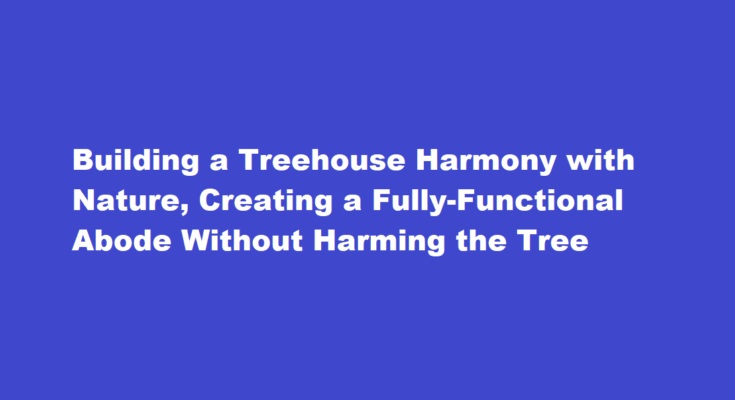Introduction
Treehouses are a timeless symbol of childhood dreams and a great way to reconnect with nature. However, building a treehouse that is fully functional and eco-friendly can be a challenge. Ensuring that the tree remains healthy and undamaged is crucial to maintaining a sustainable and lasting structure. In this article, we will explore the essential steps to build a fully-functional treehouse without harming the tree, fostering a harmonious relationship between humans and nature.
Tree Selection and Evaluation
Choosing the right tree is the foundation of a successful treehouse project. Opt for a sturdy, healthy, and mature tree with strong branches that can support the weight of the structure. Avoid trees with signs of disease, decay, or any visible stress. Evaluate the tree’s species, as some are more resilient to load-bearing than others. Popular choices include oak, maple, and beech trees.
Obtain Necessary Permissions
Before starting your treehouse project, ensure you have obtained all required permits and permissions from local authorities and property owners. Compliance with building codes and regulations will not only protect the tree but also ensure your safety and the structural integrity of the treehouse.
Hire a Professional Arborist
Consult with a certified arborist before and during the treehouse construction. An arborist can assess the tree’s health and recommend appropriate measures to minimise impact. They can guide you on where to attach support beams and how to avoid damage to vital parts of the tree, such as the root system and bark.
Choose Tree-Friendly Building Techniques
To minimise harm to the tree, opt for building techniques that do not involve driving nails directly into the trunk or branches. Use a treehouse attachment bolt (TAB) system, which secures support beams to the tree without damaging its core. TABs allow the tree to move and grow naturally while maintaining a strong connection to the structure.
Design for Growth
Trees are living organisms that continue to grow and change shape over time. Account for this growth in your design by incorporating adjustable components that can adapt to the tree’s growth without causing stress on the structure. Flexible materials and fasteners will ensure the treehouse can withstand natural movement and changes in girth.
Minimise the Environmental Footprint
Opt for sustainable and eco-friendly materials for your treehouse construction. Use responsibly sourced wood, recycled materials, and non-toxic finishes to reduce the environmental impact. Keep the footprint of the treehouse small and limit the number of trees disturbed during construction.
Preserve the Tree’s Health
During the construction process, take measures to protect the tree’s health. Avoid cutting or pruning major branches, as this can jeopardise the tree’s stability and vitality. Provide sufficient airflow and sunlight around the tree to promote healthy growth and prevent disease.
Install a Protective Barrier
To avoid potential harm caused by rubbing or abrasion between the tree and the treehouse, install a protective barrier such as rubber padding or metal flashing at potential contact points. This barrier will allow for movement without causing friction damage.
Regular Inspections and Maintenance
Perform regular inspections and maintenance on the treehouse to ensure its continued stability and the tree’s well-being. Check for signs of wear, decay, or pest infestations. Conduct seasonal inspections to address any issues promptly.
FREQUENTLY ASKED QUESTIONS
How do you make a treehouse that doesn’t hurt the tree?
Splitting the treehouse over two or more trees will keep the applied weight acting straight down through the trunk. Building a circular treehouse around a tree will do the same thing. It is easy for a treehouse to get over 1000kg (2200 lb) which is a lot of extra weight for the tree to take.
What are the disadvantages of living in a treehouse?
Living in a tree can make you especially susceptible to adverse weather conditions. Most treehouses are posted on stilts, making them not the most stable option. Sure, trees themselves can be pretty sturdy, but even they can be uprooted in an awful storm.
Conclusion
Building a fully-functional treehouse without harming the tree is a rewarding endeavour that fosters a deeper connection with nature. By selecting the right tree, employing tree-friendly building techniques, and prioritising the tree’s health, we can create a sustainable and long-lasting structure. Let us embark on this journey with mindfulness, preserving the natural beauty and life-giving essence of our majestic trees, while we build cherished memories in our harmonious treehouse abodes.
Read Also : Crafting an Imaginary Language Unveiling the Art of Constructing Grammar and Vocabulary



